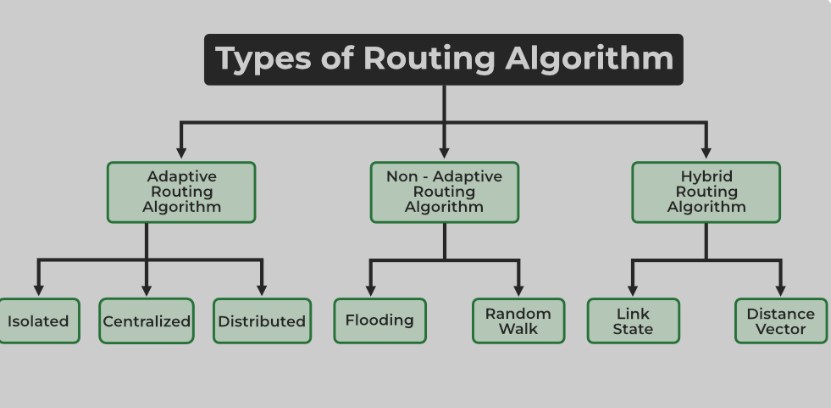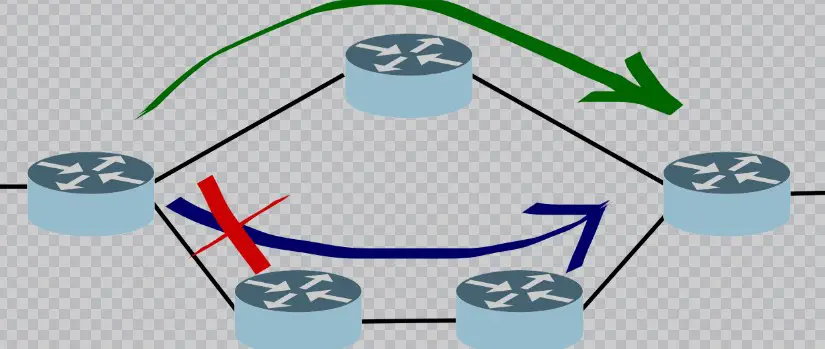Routing algorithms are the unsung heroes of our connected world, responsible for the seamless delivery of data across networks. From the webpage you’re browsing to the email you just sent, these algorithms determine the most efficient path for data packets to travel. They are crucial for maintaining the speed and reliability of network communication, ensuring that information finds its way through the complex maze of the internet and private networks.
The core difference between adaptive and non-adaptive routing algorithms lies in their approach to selecting paths for data transmission. Adaptive routing algorithms dynamically adjust their routing decisions based on current network conditions, such as traffic and link failures. On the other hand, non-adaptive routing algorithms rely on pre-established paths determined at the start of their operation, without regard for changing network scenarios.
As networks grow in complexity and size, the choice between adaptive and non-adaptive routing becomes critical. Adaptive algorithms offer the flexibility to navigate changing network conditions, potentially providing more efficient data delivery. Non-adaptive algorithms, while simpler and less resource-intensive, may not perform as well in dynamic or unpredictable environments. This distinction highlights the importance of understanding both types of routing algorithms to optimize network performance and reliability.

Core Concepts
Routing Algorithms
Routing algorithms are the brains behind network communication, determining the optimal path for data packets to travel from source to destination. These algorithms play a crucial role in ensuring data reaches its intended recipient efficiently, reliably, and quickly. In essence, they manage the flow of data across the complex maze of interconnected networks and devices that make up the internet and private networks.
There are primarily two types of routing algorithms: adaptive and non-adaptive. Adaptive algorithms dynamically adjust routes based on current network conditions, such as traffic load and link failures. Non-adaptive algorithms, on the other hand, use static routes predetermined regardless of network changes. Both types serve essential functions, with their suitability varying according to network requirements, size, and desired flexibility.
Adaptive Routing
Adaptive routing algorithms are characterized by their ability to respond to real-time changes in the network. These algorithms can adjust the paths packets take based on current network conditions, ensuring optimal performance and reliability.
How it works: Adaptive routing uses dynamic decision-making to select paths. This process involves continuously monitoring the network for changes in topology, congestion levels, and link status, adjusting routes as necessary. This flexibility allows adaptive routing to optimize data delivery, adapting to varying conditions to maintain or enhance performance.
Advantages and applications: The primary advantage of adaptive routing is its resilience and efficiency. It is particularly well-suited for large, constantly changing networks where static routes could lead to congestion, bottlenecks, or even failure. Applications include large-scale enterprise networks, internet backbone networks, and wireless communication networks, where maintaining high levels of performance and reliability is paramount.
Non-Adaptive Routing
Non-adaptive routing algorithms, by contrast, use predetermined, static routes. Once these routes are set, they do not change in response to network conditions.
How it works: This approach involves establishing fixed paths for data packets at the network’s initialization phase. These routes remain constant, regardless of any changes within the network, such as increased traffic or failed links.
Advantages and applications: Non-adaptive routing’s main advantage is its simplicity and predictability. It is easier to implement and maintain, making it suitable for smaller or more stable networks where changes are infrequent or predictable. Typical applications include small business networks, home networks, and certain types of specialized communication systems.
Comparative Analysis
Decision Basis
Adaptive routing decisions are based on real-time network conditions, including congestion levels, link failures, and topology changes. This allows for flexible and optimized routing. In contrast, non-adaptive routing relies on predefined paths that do not change, regardless of current network conditions, prioritizing simplicity and stability over flexibility.
Performance and Scalability
Adaptive routing excels in responding to network changes, maintaining or improving performance as conditions evolve. This makes it highly scalable, able to accommodate the growth and increasing complexity of networks. Non-adaptive routing, while less flexible, can offer consistent performance in stable environments but may struggle to maintain efficiency in dynamic or growing networks.
Complexity and Cost
Adaptive routing comes with higher implementation complexity and operational costs, due to the need for continuous monitoring and dynamic decision-making. Non-adaptive routing, being simpler, requires less initial setup and maintenance effort, making it cost-effective for smaller or less complex networks.
Use Cases
Adaptive routing is ideal for environments where network conditions are unpredictable or highly variable, such as in large enterprise networks or the internet backbone. Its ability to dynamically adjust routes ensures optimal performance and reliability in these complex scenarios.
Non-adaptive routing suits smaller, more stable environments where network conditions change infrequently. Its simplicity and predictability make it a good fit for smaller business or home networks, where ease of setup and maintenance are key considerations.
Challenges and Solutions
Adaptive Routing Challenges
Overhead and Latency
Adaptive routing algorithms adjust routes based on network conditions, leading to increased overhead and latency. Every router in the network must exchange information with its neighbors, consuming bandwidth and processing resources. This exchange can delay packet delivery as routers take time to compute and propagate new routes.
Complexity in Implementation
Implementing adaptive routing is inherently complex. Routers require sophisticated algorithms to monitor network conditions, predict traffic patterns, and calculate optimal paths. This complexity not only increases the initial setup cost but also necessitates ongoing maintenance by skilled personnel.
Non-Adaptive Routing Challenges
Lack of Flexibility
Non-adaptive routing operates on static routes that do not change in response to network traffic or topology changes. This lack of flexibility can lead to suboptimal routing decisions, especially in dynamic networks where traffic patterns and link statuses change frequently.
Inefficiency in Dynamic Networks
In dynamic networks, the inability of non-adaptive routing to adjust to changes can lead to inefficient use of network resources. Fixed routes might become congested or fail, causing packet loss and delays without any mechanism to reroute traffic automatically.
Overcoming Challenges
Hybrid Approaches
Hybrid routing algorithms combine the adaptability of adaptive routing with the simplicity of non-adaptive routing. By using static routes under normal conditions and switching to dynamic routing during congestion or link failures, hybrid approaches can optimize network performance while minimizing overhead.
- Selective adaptability: Dynamic routing for critical or congested areas
- Threshold-based activation: Switching to adaptive routing based on predefined criteria
Recent Advancements and Technologies
Innovations in networking technologies have introduced solutions to mitigate the challenges associated with both routing approaches.
- Software-Defined Networking (SDN): Separates the network’s control plane from the data plane, enabling centralized management and dynamic route optimization.
- Network Function Virtualization (NFV): Allows network functions to run on virtual machines, improving flexibility and reducing dependency on physical infrastructure.
- Advanced routing protocols: Protocols like Segment Routing leverage network state information to optimize path selection dynamically.
Future Directions
AI and Machine Learning in Routing
The integration of AI and machine learning technologies into routing algorithms holds great promise for the future. By analyzing vast amounts of network data, AI can predict traffic patterns, identify potential bottlenecks, and automatically adjust routing decisions to optimize performance.
- Predictive routing: AI algorithms predict traffic flows and adjust routes preemptively.
- Anomaly detection: Machine learning identifies and mitigates potential network issues before they impact performance.
Predictive Modeling for Routing Decisions
Predictive modeling uses historical data and real-time analytics to make informed routing decisions. This approach can foresee potential network conditions and adjust routes accordingly, minimizing the impact of congestion, failures, and other dynamic network challenges.
- Real-time traffic analysis: Continuously monitoring traffic flows to adjust routes on the fly.
- Capacity planning: Using historical data to predict future network load and adjust infrastructure accordingly.
Frequently Asked Questions
What are routing algorithms?
Routing algorithms are a set of rules or procedures used by network devices to determine the most appropriate paths for forwarding data packets from their source to their destination across computer networks. These algorithms take into account various factors, such as network topology, traffic load, and link costs, to optimize the route and ensure efficient data transmission.
How do adaptive routing algorithms improve network performance?
Adaptive routing algorithms dynamically adjust the paths taken by data packets in response to changing network conditions. This flexibility allows for the optimization of network resources, reduction of congestion, and enhancement of data delivery speeds, leading to overall improved network performance and reliability.
Can non-adaptive routing algorithms be used in large networks?
Non-adaptive routing algorithms can be used in large networks, but their effectiveness might be limited due to their static nature. They work best in stable environments where network conditions do not change frequently. In dynamic or rapidly growing networks, adaptive routing algorithms might offer better performance by adjusting routes in real-time according to the network state.
Why choose adaptive over non-adaptive routing, or vice versa?
The choice between adaptive and non-adaptive routing depends on the specific requirements and characteristics of the network. Adaptive routing is favored in environments where network conditions are unpredictable or subject to frequent changes. Non-adaptive routing, however, is simpler to implement and manage, making it suitable for smaller, more stable networks where efficiency and simplicity are prioritized.
Conclusion
The decision between adaptive and non-adaptive routing algorithms influences the efficiency, reliability, and performance of network communications. Each type has its strengths and ideal use cases, emphasizing the importance of understanding their differences and applications. Adaptive routing offers flexibility and responsiveness to changing network conditions, ideal for dynamic environments. Conversely, non-adaptive routing provides simplicity and consistency, better suited for stable, predictable networks.
As networks continue to evolve, the choice of routing algorithm will remain a crucial consideration for network administrators and engineers. The ongoing advancements in networking technologies promise to enhance the capabilities of both adaptive and non-adaptive routing, ensuring they can meet the demands of future network architectures and data communication challenges.

